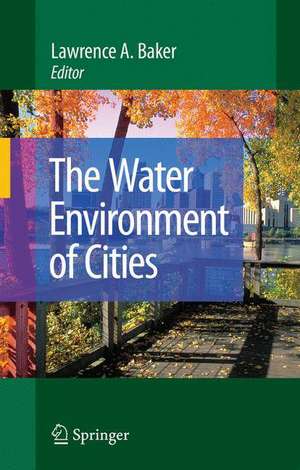The Water Environment of Cities
Editat de Lawrence A. Bakeren Limba Engleză Hardback – 16 apr 2009
| Toate formatele și edițiile | Preț | Express |
|---|---|---|
| Paperback (1) | 945.79 lei 6-8 săpt. | |
| Springer Us – 4 noi 2010 | 945.79 lei 6-8 săpt. | |
| Hardback (1) | 950.52 lei 6-8 săpt. | |
| Springer Us – 16 apr 2009 | 950.52 lei 6-8 săpt. |
Preț: 950.52 lei
Preț vechi: 1159.17 lei
-18% Nou
Puncte Express: 1426
Preț estimativ în valută:
181.88€ • 198.36$ • 153.37£
181.88€ • 198.36$ • 153.37£
Carte tipărită la comandă
Livrare economică 24 aprilie-08 mai
Preluare comenzi: 021 569.72.76
Specificații
ISBN-13: 9780387848907
ISBN-10: 0387848908
Pagini: 307
Ilustrații: 375 p. 20 illus.
Dimensiuni: 155 x 235 x 20 mm
Greutate: 0.59 kg
Ediția:2009
Editura: Springer Us
Colecția Springer
Locul publicării:New York, NY, United States
ISBN-10: 0387848908
Pagini: 307
Ilustrații: 375 p. 20 illus.
Dimensiuni: 155 x 235 x 20 mm
Greutate: 0.59 kg
Ediția:2009
Editura: Springer Us
Colecția Springer
Locul publicării:New York, NY, United States
Public țintă
Professional/practitionerDescriere
The concept for the Water Environment of Cities arose from a workshop “Green 1 Cities, Blue Waters” workshop held in 2006. The workshop assembled experts from engineering, planning, economics, law, hydrology, aquatic ecology, geom- phology, and other disciplines to present research ?ndings and identify key new ideas on the urban water environment. At a lunch discussion near the end of the workshop, several of us came to the recognition that despite having considerable expertise in a narrow discipline, none of us had a vision of the “urban water en- ronment” as a whole. We were, as in the parable, blind men at opposite ends of the elephant, knowinga great deal about the parts, but notunderstandingthe whole. We quickly recognized the need to develop a book that would integrate this knowledge to create this vision. The goal was to develop a book that could be used to teach a complete, multidisciplinary course, “The Urban Water Environment”, but could also be used as a supplemental text for courses on urban ecosystems, urban design, landscapearchitecture,water policy,waterqualitymanagement andwatershed m- agement. The book is also valuable as a reference source for water professionals stepping outside their arena of disciplinary expertise. The Water Environment of Cities is the ?rst book to use a holistic, interdis- plinary approach to examine the urban water environment. We have attempted to portrayaholisticvisionbuiltaround theconcept of water as a coreelement ofcities. Water has multipleroles:municipalwatersupply,aquatichabitat,landscapeaesth- ics, and recreation. Increasingly, urban water is reused, serving multiple purposes.
Cuprins
The Urban Water Budget.- Groundwater in the Urban Environment.- Urban Infrastructure and Use of Mass Balance Models for Water and Salt.- New Concepts for Managing Urban Pollution.- Streams and Urbanization.- Urban Water Recreation: Experiences, Place Meanings, and Future Issues.- Urban Design and Urban Water Ecosystems.- Legal Framework for the Urban Water Environment.- Institutions Affecting the Urban Water Environment.- Institutional Structures for Water Management in the Eastern United States.- Adaptive Water Quantity Management: Designing for Sustainability and Resiliency in Water Scarce Regions.- Demand Management, Privatization, Water Markets, and Efficient Water Allocation in Our Cities.- Principles for Managing the Urban Water Environment in the 21st Century.
Recenzii
From the reviews:
"This work is a collection of 14 interdisciplinary chapters of about 20 pages each, written by a variety of contributors, mostly from universities and research centers, with backgrounds in such areas as economics, law, engineering, sustainability, and urban design. The book … is intended primarily as a resource for a course on the topic of the title, but it is also useful for traditional courses in urban design, water policy or quality management, or watershed management. … Summing Up: Recommended. Upper-division undergraduate through professional collections." (D. A. Vaccari, Choice, Vol. 47 (2), October, 2009)
"This work is a collection of 14 interdisciplinary chapters of about 20 pages each, written by a variety of contributors, mostly from universities and research centers, with backgrounds in such areas as economics, law, engineering, sustainability, and urban design. The book … is intended primarily as a resource for a course on the topic of the title, but it is also useful for traditional courses in urban design, water policy or quality management, or watershed management. … Summing Up: Recommended. Upper-division undergraduate through professional collections." (D. A. Vaccari, Choice, Vol. 47 (2), October, 2009)
Notă biografică
Dr. Baker is a Senior Fellow in the Minnesota Water Resources Center and owner of WaterThink, LLC, a consulting firm specializing in innovative approaches to water quality management. He had been on the faculty of the Department of Civil and Environmental Engineering at Arizona State University and served as Technical Director for a national synthesis of surface water acidification at EPA’s Corvallis EPA laboratory. His research examines water in human ecosystems, at scales from households to urban regions, with the goal of developing novel approaches for reducing pollution that are more effective, cheaper and fairer than conventional approaches.
He has published more than 100 technical papers, edited one book, Environmental Chemistry of Lakes and Reservoirs, and is on the editorial board of the journal Urban Ecosystems. In addition to technical articles, he frequently writes columns for the Minneapolis Star and Tribune, The Minnesota Journal, and several practitioner magazines. His is currently working on a trade book, The End of Pollution.
He has served on a number of environmental science and policy synthesis projects at the national scale and in Minnesota and Arizona.
Chapter authors include Robert W. Adler, Associate Dean for Academic Affairs and James I. Farr Chair and Professor at the University of Utah, S.J. Quinney College of Law; Cliff Aichinger, Administrator for the Ramsey-Washington Metro Watershed District in St. Paul; Brian Bledsoe, Associate Professor in the Department of Civil and Environmental Engineering at Colorado State University; Derek Booth, President and Senior Geologist at Stillwater Sciences, Inc. and an Adjunct Professor of Civil Engineering and Earth & Space Sciences at the University of Washington; John Crittenden, the Richard Snell Professor of Civil and Environmental Engineering at Arizona State University; K. William Easter, Professor in Applied Economics at the University of Minnesota and former Director of the Center for International Food and Agricultural Policy; Kristina Hill, Professor of Landscape Architecture and Urban Design at the University of Virginia; Jim Holway, Associate Director of the Global Institute of Sustainability at Arizona State University and formerly, Assistant Director of the Arizona Department of Water Resources; Ingrid E. Schneider, Professor in the Department of Forest Resources at the University of Minnesota and Director of the University of Minnesota’s Tourism Center; Peter Shanahan, Senior Lecturer in the Department of Civil and Environmental Engineering at MIT; Claire Welty, Director of the Center for Urban Environmental Research and Education and Professor of Civil and Environmental Engineering at University of Maryland, Baltimore County; and Paul Westerhoff, Professor and Chair of the Department of Civil and Environmental Engineering at Arizona State University.
He has published more than 100 technical papers, edited one book, Environmental Chemistry of Lakes and Reservoirs, and is on the editorial board of the journal Urban Ecosystems. In addition to technical articles, he frequently writes columns for the Minneapolis Star and Tribune, The Minnesota Journal, and several practitioner magazines. His is currently working on a trade book, The End of Pollution.
He has served on a number of environmental science and policy synthesis projects at the national scale and in Minnesota and Arizona.
Chapter authors include Robert W. Adler, Associate Dean for Academic Affairs and James I. Farr Chair and Professor at the University of Utah, S.J. Quinney College of Law; Cliff Aichinger, Administrator for the Ramsey-Washington Metro Watershed District in St. Paul; Brian Bledsoe, Associate Professor in the Department of Civil and Environmental Engineering at Colorado State University; Derek Booth, President and Senior Geologist at Stillwater Sciences, Inc. and an Adjunct Professor of Civil Engineering and Earth & Space Sciences at the University of Washington; John Crittenden, the Richard Snell Professor of Civil and Environmental Engineering at Arizona State University; K. William Easter, Professor in Applied Economics at the University of Minnesota and former Director of the Center for International Food and Agricultural Policy; Kristina Hill, Professor of Landscape Architecture and Urban Design at the University of Virginia; Jim Holway, Associate Director of the Global Institute of Sustainability at Arizona State University and formerly, Assistant Director of the Arizona Department of Water Resources; Ingrid E. Schneider, Professor in the Department of Forest Resources at the University of Minnesota and Director of the University of Minnesota’s Tourism Center; Peter Shanahan, Senior Lecturer in the Department of Civil and Environmental Engineering at MIT; Claire Welty, Director of the Center for Urban Environmental Research and Education and Professor of Civil and Environmental Engineering at University of Maryland, Baltimore County; and Paul Westerhoff, Professor and Chair of the Department of Civil and Environmental Engineering at Arizona State University.
Textul de pe ultima copertă
For much of the first 200 years of industrialization, the urban water environment was developed by trial and error, often with unintended consequences. The modern "water closet" became widely used; public officials realized that sewers were needed, epidemics of cholera and typhoid were rampart, and eventually, the Cuyahoga River in Ohio literally caught fire. Along the way, we developed new science, new technology, and new institutions. Will we do better in the future? Can we do better in the developing world? This central premise of this book is that we can, if we plan the urban water environment holistically.
The Water Environment of Cities is the first book to develop this holistic vision. To accomplish this, core chapters are written by leading experts in academia, consulting, and government. It is written for the broad audience of urban water managers: engineers, planners, ecologists, hydrologists, social scientists, and others. Chapters are written to be accessible to students and practitioners across disciplines, each incorporates cross-cutting themes, and the book is supported by a glossary. Chapters examine urban water budgets, groundwater management, urban water infrastructure, the movement of pollutants through urban systems, management of urban streams, integration of water into planning design, urban water recreation, the legal framework for urban water management, institutions to manage urban water, and the economics of water supply. Importantly, after writing their core chapters, chapter authors participated in an NSF-funded synthesis workshop to integrate concepts throughout the book. The result is a unique synthesis chapter that outlines five core principles for managing the urban water environment in the 21st century.
The Water Environment of Cities is the first book to develop this holistic vision. To accomplish this, core chapters are written by leading experts in academia, consulting, and government. It is written for the broad audience of urban water managers: engineers, planners, ecologists, hydrologists, social scientists, and others. Chapters are written to be accessible to students and practitioners across disciplines, each incorporates cross-cutting themes, and the book is supported by a glossary. Chapters examine urban water budgets, groundwater management, urban water infrastructure, the movement of pollutants through urban systems, management of urban streams, integration of water into planning design, urban water recreation, the legal framework for urban water management, institutions to manage urban water, and the economics of water supply. Importantly, after writing their core chapters, chapter authors participated in an NSF-funded synthesis workshop to integrate concepts throughout the book. The result is a unique synthesis chapter that outlines five core principles for managing the urban water environment in the 21st century.
Caracteristici
Focuses on the U.S. because it is already highly urbanized (85%), spans a wide range of hydrologic settings, has diverse urban water institutions, and is well-studied
Offers new paradigms for urban water management, emphasizing innovative concepts
Includes supplementary material: sn.pub/extras
Offers new paradigms for urban water management, emphasizing innovative concepts
Includes supplementary material: sn.pub/extras














